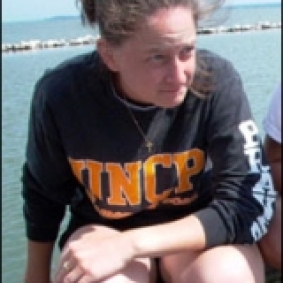Eight students will be presenting the summer work at the Ocean Sciences Meeting in March 2022!
Barbara (Jacobson) Smith, University of North Carolina Pembroke
Class Year:
2004Mentor:
Michael Kemp, Ph.D.Project Title:
Nutrient Cycling and Biogeochemistry of Sediments Inhabited by Two Contrasting Submersed Plant Species
Abstract:
Sediment biogeochemistry and nutrient cycling was investigated in estuarine beds of two species of submersed plants, Potamogeton perfoliatus and Ruppia maritime. Comparing beds of these two species, overall plant biomass was 1.5 to 2 times higher and ratios of above-ground to below-ground biomass were 2 to 3 times higher for P. perfoliatus. Rates of photosynthetic O2 production per unit plant biomass were similar between the two plant species; however, biomass-specific respiration rates were significantly higher for P. perfoliatus. Fluxes of key solutes, including O2, N2, DOC, DON, NH4+, and NO3- were measured using triplicate intact sediment cores collected from within each plant bed (containing plants, sediment and water) and from adjacent areas without vascular plants (containing only sediment and water). Sediment at each sampling site was also characterized by measurements of benthic chlorophyll-a content and solid-phase nutrient concentrations. Higher rates of total inorganic nitrogen recycling in P. perfoliatus sediments suggest enhanced trapping of particulate organic matter. Rates of coupled nitrification-denitrification (dark N2 flux) were significantly higher in sediments containing both submersed plants than in adjacent 'bare' sediments, and rates were four-fold higher in P. perfoliatus sediments in comparison to R. maritime beds. These results suggest that the relatively widespread distribution of the opportunistic plant species, R. maritime, can initiate changes in sediment biogeochemistry that could promote further growth of submersed plants in otherwise marginal habitats. On the other hand, more stable plant species such as P. perfoliatus appear to have even greater ability to enhance sediment conditions by increasing nutrient recycling rates while maintaining relatively low rates of nutrient release to overlying water and associated stimulation of algal growth. These results, thus, provide valuable information to help guide submersed plant restoration in these estuarine regions.




